Scouring the internet for freelancer platform comparisons will result in a few problems. Firstly, many of the top ranking results are woefully out of date. Secondly, they tend to be written from one of two perspectives: the buyer (the person who wants the job done) or the seller (the freelancer). What you don’t get is a comprehensive picture of freelance site comparisons from both sides of the fence.
Obviously out of date info helps no-one. If a buyer believes a seller on People Per Hour is only losing 3.5% in fees, then they will feel mightily cheesed off with a price that in fact needs to absorb 20% in fees, plus an extra 4% for other things we can’t quite quantify. Conversely, the seller is going to feel that the buyer wants slave labour. Not the best start to a productive project.
The freelance economy is an incredibly exciting and dynamic place to be right now. The UK freelance economy is worth at least an eye-watering £125bn each year. Data from the ONS and industry analysis states that by 2020 half of the whole UK workforce could be self-employed. So, where does that leave freelance website comparisons in 2019?
Our overall comparison of freelancer sites
We’ll come on to the detail later in this article. But for those wanting a very quick overview, here’s our verdict following our comparison exercise:

Freelance platforms
Let’s leave aside the arguments about the ‘gig’ economy for a moment. Freelance platforms are actually ideal – in theory – for many businesses and many individuals.
Freelancing allows remote working, setting your own agenda, flexibility and diversity. However, you need to find the work. For businesses they can get projects done in a far more flexible way, without painful overheads. Freelancers enable small businesses, particularly, to access the talent that allows them to compete with the big guys.
Freelance platforms aim to marry these two together. All freelancing platforms start out with this aim: match buyers with sellers. The best price and the best talent wins. Win-win all round in fact.
However, somewhere along the lines, the freelance sites themselves started getting a little lost. A small slice of the pie has now become a greedy wodge. Let’s take some basic numbers that represent a fictional, but highly close to reality, freelancer platform. This could, more or less, be a breakdown of any of the major freelance platforms:
Our case study: A buyer wants a 1000 word blog post written. They choose a seller who says this will be £50. The seller pays the freelance platform 25% in fees. The buyer pays the freelancer platform 10% in fees. The buyer actually pays £55. The seller actually receives £37.50. The freelance platform rakes in a whopping £17.50.
Now let’s look at exactly how big that is as a slice of the pie.
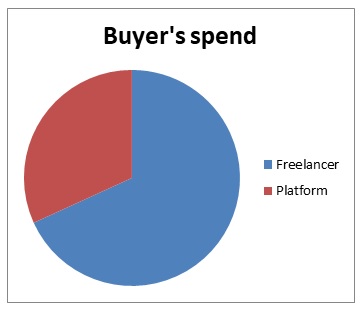
Even if we take in to account that, of course, the freelance platform has overheads to cover and a service to pay for, we can say that is one greedy pie eater.
But let’s back up a little. Perhaps by seeing what a freelance platform actually does, we can understand why fees have hiked so much in recent years.
How do freelancer platforms work?
Of all the various freelance platforms, there are some main contenders. This article is going to look in detail at four of them: People Per Hour, Upwork, Fiverr and Freelancer. We should state at this point: we aren’t affiliated with any of them. This is an unbiased and honest comparison of freelancing sites.
Of these four sites, they do have slightly different ways of working. They also have slightly different terminology. However, the overriding concepts are the same. Fiverr works a bit differently, but for all the others, this is how it works:
Freelancers create profiles. Here they will list their skills and showcase their portfolio. There will also be a review system, and likely a ranking system (against other freelancers). This gives the buyer a good indication of the ability of the individual freelancer, and their suitability for their project.
When a buyer comes along, wanting to get a project done, they list a job (sometimes referred to as a gig or a project). They create a listing for the project. This will include details such as description, scope, deadline and, of course, budget. When they submit the listing, they are also likely to be encouraged to ‘invite’ or pick particular freelancers to apply.
The listing then goes live. A flurry of freelancers then submits proposals or bids. The buyer then works through the proposals and picks the freelancer they believe is best suited to their project, in the budget. The buyer will then accept the relevant proposal and pay the money which goes and sits nice and snugly in an escrow account.
The freelancer now gets on and completes the project. Once the buyer is happy, they whizz over an invoice. The funds (minus fees) are then released to the freelancer. Reviews are left. Job done.
The benefits of freelance platforms
There is no doubting that freelance sites offer some real benefits.
Benefits for the buyer of using a freelancer site:
· Access to a wide range of freelancers from around the world.
· Bidding process should ensure ‘best price’.
· Ability to see reviews and portfolios in one place.
· Only pay for what you need, rather than an employee with overheads like pensions and N.I. contributions.
· Safe payment options where money is only handed to the freelancer when you’re happy.
· Clear price for a job done, rather than open-ended hourly working.
Benefits for the freelancer of using a freelancer site:
· Access to globally available jobs on a flexible basis.
· Opportunity to build a strong profile based on feedback and reviews.
· Safe payment system with a third party controlling funds.
· Chance to build a freelancing career through developing client relationships.
· Remote working to suit your lifestyle.
· You can see reliability of buyers in terms of their feedback ratings.
· You can make use of various tools such as invoice generation, testing, and time management tools.
· Tasks worked out on a fixed fee rather than potentially messy hourly rates. No time-tracking needed.
Now the question is: do freelance platforms, as we head in to 2019, deliver well on these ‘benefits’ still?
The only way to get a true answer to these questions, and a fair comparison of freelancer platforms, is to head to the platforms themselves. We decided to post the same job to the four leading freelance platforms for UK freelancers: People Per Hour, Upwork, Fiverr and Freelancer.
We took a look at these freelance platforms from the point of view of both buyer and seller. We specifically looked at the ease of the process involved, the quality and quantity of freelancers matched with our project, and the fees.
Our project
Being a bunch of word nerds, we opted for a writing project. This way we could compare the freelancer sites in the context of our own understanding of our industry. However, the same concept applies whether it’s a logo design task, SEO keyword report, data processing or whatever works well on a freelance basis.
Our project was intentionally kept simple and was listed on all sites thus:
“I need a 1000 word post in the start-up niche. More details will be provided to the successful freelancer. Writer needs to be able to write with SEO best practices and share examples of their work.”
We ran the listing for 4 hours on each site before cancelling. We did this because on some sites, freelancers use credits (which they have to pay for) to bid. By cancelling the job, the freelancer gets their credit back.
Let’s look at the results.
Our project on People Per Hour
Listing a project on PPH is pretty straightforward. However, it is one of the most time intensive of the bunch. This isn’t actually a bad thing – your project does deserve some time.
You fill in some simple info. The problem is, that although this goes to moderation, very brief ‘briefs’ get through. Ours is a good example. For freelancers to make an informed bid, they could really do with a bit more information than we gave.
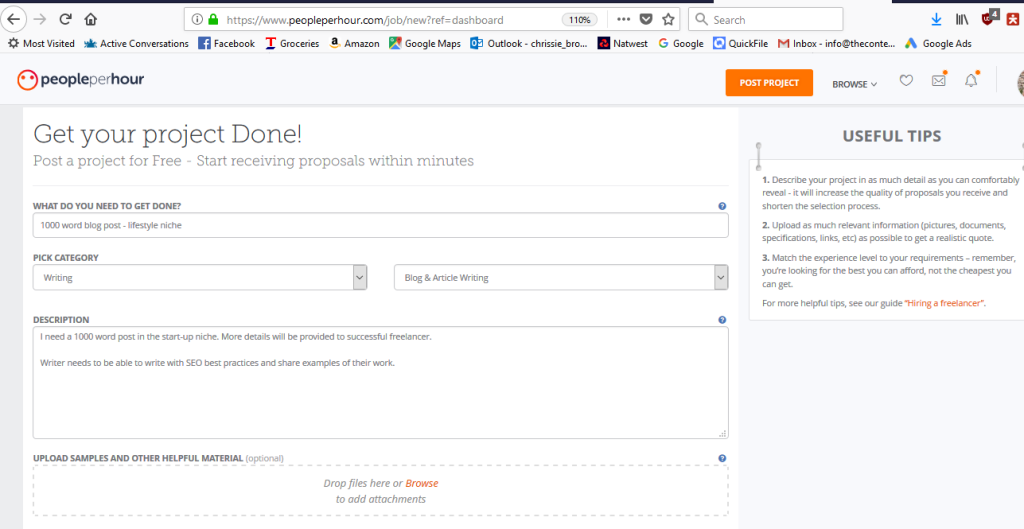
As a buyer, you can opt to ask additional questions. This isn’t a requirement. Furthermore, the suggested questions are not necessarily going to get you the sort of answer you really need.
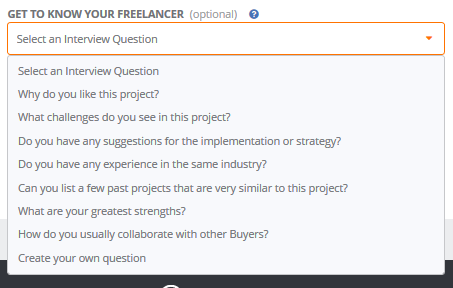
Now anyone who knows anything about recruitment, knows that these generic questions, particularly in relation to a one off job, aren’t going to elicit the information you need. This is especially true when the ‘interviewee’ is writing their answer. They have time to think (and copy and paste from the million other proposals they write). We highly recommend buyers choose their own questions, or simply use portfolios to match a freelancer to the project.
You also get to set the budget. This is a bit wooly. It is determined by whether you’re looking for an ‘entry’ freelancer, ‘intermediate’ or ‘expert’. You can set a fixed price, or leave it open.
This is also complicated by the fact that you can choose the price based on ‘CERT’ rating. CERT is a review and turnover based ranking system that People Per Hour uses to rank their freelancers. Everyone starts off as Level 1, quickly moves to Level 2 and then gradually works their way up to CERT 5 and finally may become one of the ‘TOP’ sellers.
There’s not too much clarity on how ‘CERT’ actually works. It takes data from a number of factors such as reviews, the amount of work you bill, regularity of work, how quickly you communicate etc.
Choosing CERT as a pricing scale is presumably designed to show you the price you can expect for a certain level of expertise and quality. As a broad brush stroke, this is probably true. However, you’re instantly wiping out newbies to the platform who are actually highly skilled. You’re also wiping out the most skilled freelancers who do much of their work through other avenues, and therefore simply don’t bill as much through the platform.
Then it all gets a bit salesy for the poor old buyer. You get faced with a list of extras you can buy. The uninitiated will think they are getting something great here. Nope. For example, if you pay to feature the job, this only puts a blue banner across the corner and puts it at the top of the job listings page. Bear in mind a freelancer will have their own search parameters for jobs. This doesn’t do anything except potentially attract a large number of low quality freelancers who don’t scroll very well.
We don’t think any of the extras are worth it for buyers. Just put the information in your listing and the freelancers themselves will self-screen.
Next you get a few freelancers highlighted to you. Sometimes these will be randomly selected freelancers who meet your entry-intermediate-expert or CERT requirements. Sometimes they are freelancers who themselves have paid to feature their profile. Again, we’re not sure that’s the best approach to actually getting the best. Nonetheless, you get to invite any you like the look of, to bid on your project specifically.
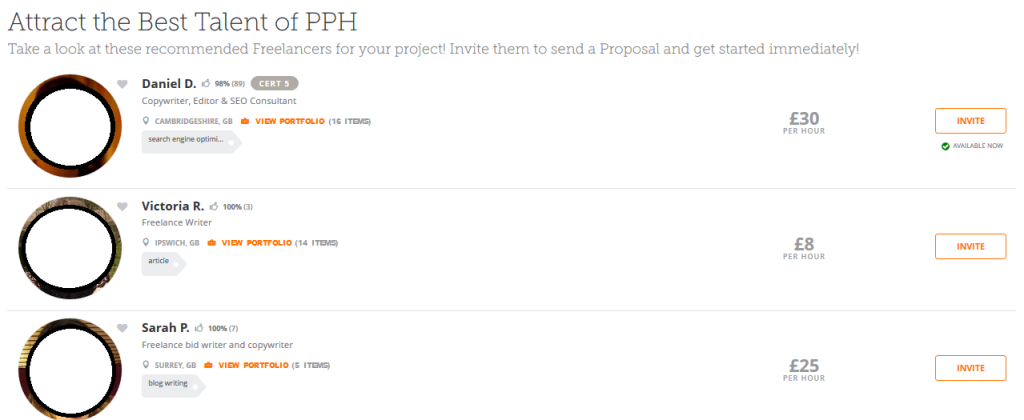
So now your job is listed.
Listing our job on People Per Hour – The Results:
In 4 hours we had 8 proposals and two direct contacts. We would have expected more. This is a global platform and writers (even if they aren’t particularly fabulous), are two-a-penny. Perhaps we should have paid to feature it or use a ‘talent scout’ after all?!
Now of those proposals, only two were based in the UK. Five, out of six of the remaining proposals, were by freelancers who don’t have English as a first language. One direct quote to satisfy some curiosity: “CONTENT is the fresh bred for the Google”. Oh dear. You can see how the proposals are listed for you, here:
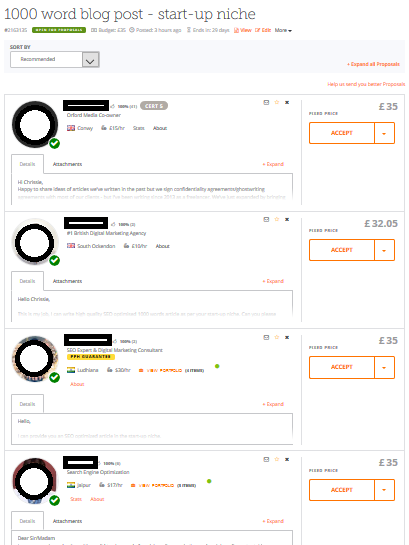
Half didn’t include the samples as we requested. Of those that did, all failed what we at The Content Ninja consider to be basic SEO principles and readability levels. 27 word sentences? No thank you. No sub-headings? Nah.
If the job was real, there was one possible suitable freelancer on People Per Hour, but we would have felt pretty bitter about the fees.
What about People Per Hour Fees?
Ok, now brace yourself, this is a little complicated.
Buyers pay a service fee of 10% plus £0.60 on each project. There are all the additional fees you could opt for as well, like a featured listing (which comes with no guarantees according to the T&Cs), or listing your job with an NDA (a staggering £26 which doesn’t include any enforceability).
Freelancers get a tougher deal. Below £500 the fee is 20% excluding VAT with a minimum service fee of £2.50 per invoice. Freelancers also have to ‘buy’ proposal credits over their allotted 15 per month. Bidding on a high value job (which may only be £70) uses three bid credits.
It should also be noted there are fees for the freelancer if they raise a dispute. Say for example, a buyer refuses to pay. The freelancer will be charged 10% of the invoice amount. Ouch.
People Per Hour – the good, the bad, the ugly
The Good: We like that you can, if you wish, put in a very detailed brief. The more information the freelancer has, the more accurate their proposal will be.
The Bad: We don’t like that buyers are able to pay more for supposed access to better freelancers. We believe it should be on talent, suitability and availability alone.
The Ugly: The fees are painful, for both sides, but particularly the freelancer. We can’t see what the platform actually does to justify such fees. For the buyers they are the highest of all the platforms.
Our Project on Upwork
Upwork is super quick to register as a buyer. We estimate that you can have a project listed in less than 2 minutes (we’re not saying you should!).
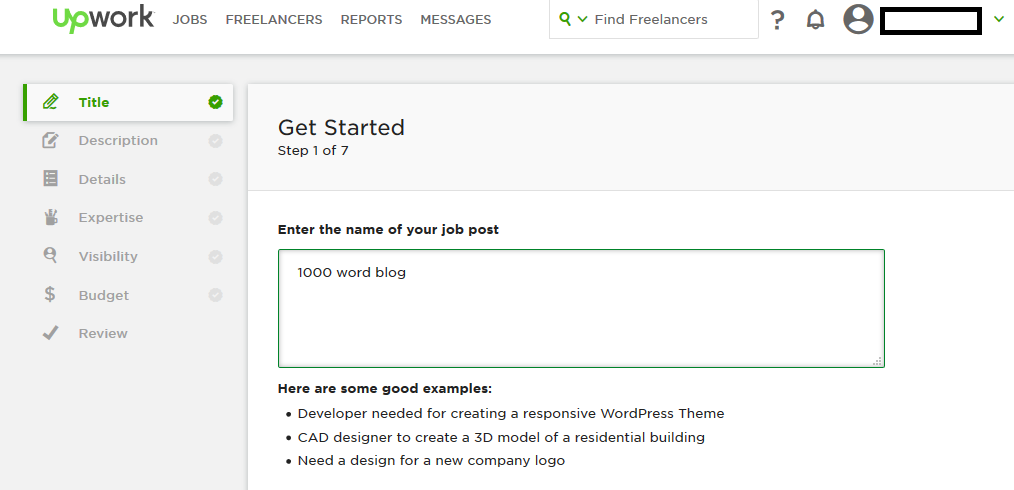
You are walked through some quick and simple steps to get your project listed. Like People Per Hour, you can add some generic ‘interview’ questions.
On Upwork, you can select the most relevant skills for your job. This should tally with the skills freelancers have listed on their profile. Good, we’re narrowing the field to worthwhile candidates.
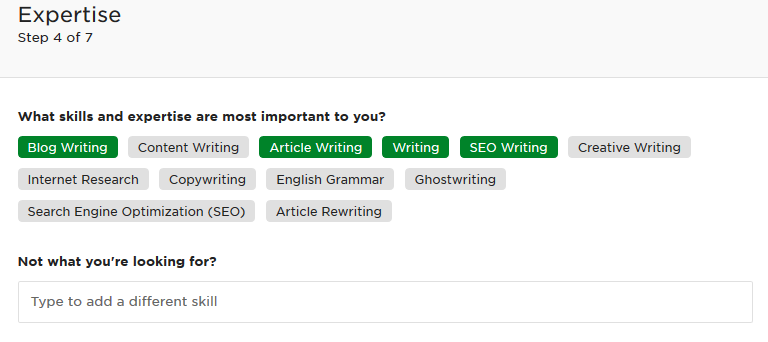
You also get to choose whether your listing will go public, just to Upwork freelancers, or only to those you specifically invite.
Buyers then choose whether to pay a fixed price, or by the hour. Even though we are a ‘buyer’ in the UK, all costs are listed in USD. Presumably that means conversion fees somewhere. This is particularly crazy if you hire a UK freelancer for a UK job. Both will lose out.
Anyway, now you can post the job and wait for proposals to come in.
Listing our job on Upwork – The Results:
In four hours listed on Upwork, we only received 4 proposals. Pretty disappointing really. Out of the four, only one was UK-based and had English as a first language.
What’s more, that one UK freelancer only has a feedback rating of 90%. It may sound harsh, but that’s a little low for us to feel confident that they consistently deliver high-quality content, we’d like to see over 95% at least. Looking more closely at the freelancer’s profile, we also weren’t happy with the quality of their work, particular in terms of SEO: one of our only requirements.
Without wishing to write off skilled writers who have English as a second language, we took a good look at the other three proposals. Here we ran in to a few problems. The errors were blinding. Even where they were largely ‘technically’ correct, web content really requires a conversational tone which wasn’t demonstrated. A few examples:
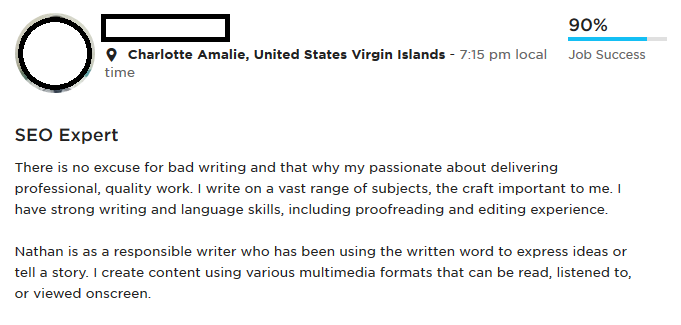
There were a few other cringe-inducing examples. One listed “No Plagiarism, No Copyscape, No Grammer Issues, Only Relevant and Original work.” No spelling either it seems. Another started off calling us “their esteemed client” and went on in a painfully formal tone that doesn’t really fit in to the UK business culture these days.
If the job was real, we wouldn’t have chosen any freelancers from Upwork. This is concerning as a number of our freelancers here at The Content Ninja, who have proven track records of excellency, have been turned down from Upwork. The reason given to them is that Upwork already has enough freelancers with their skills. Where were they then?
What about Upwork Fees?
Upwork offer tiered fees to freelancers. The basic premise is that the more you bill a particular client, the less you pay. This is very similar to People Per Hour. For the first $500 dollars billed, you are charged 20%. So again, very in line with People Per Hour.
Buyers get a better deal on Upwork. They are charged a payment processing and administration fee of 2.75%. If you wish, and you are eligible, you can choose to pay a flat payment processing fee of $25 for all payments in a one month period (so worth it for frequent buyers). However, you’ll need to have used Upwork for at least 90 days and paid a minimum of $1000 in the last year.
On Upwork, buyers can also buy Upwork Pro membership, for $149 per month. We’re a little wary of this. It’s designed to help you sift out less-than-qualified freelancers. However, if you only get so few applying to a job, that’s really pretty easy to do.
Upwork – the good, the bad, the ugly
The Good: It’s super-fast to list a job. We also like the theory of limiting the number of freelancers on the platform in theory. It should make it easier to curate and provide quality to buyers.
The Bad: The curation of talent clearly doesn’t work. We know exceptional freelancers turned away from Upwork, yet the proposals we saw were shoddy to say the least.
The Ugly: Only four proposals, none of them suitable, poor form.
Our Project on Fiverr
Before we get in to specifics, Fiverr does work quite differently compared to the other freelancing sites. It started out life as a way of selling quick services, for a fiver. Those roots are still there.
It takes a good bit of faffing around to set up as a buyer on Fiverr. What’s more, you quickly discover that really, you’re doing ALL the legwork. It’s basically a glorified search engine.
It starts off promising by letting you define the parameters of your job:
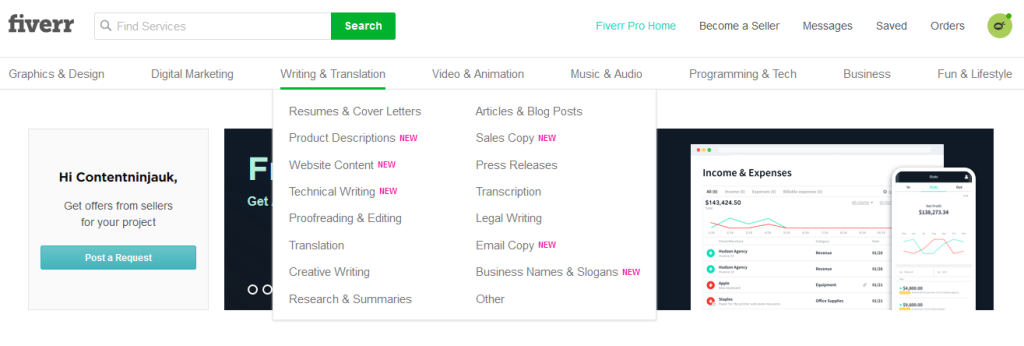
We were then able to refine it further. We chose ‘Article and Blog Posts’. We could choose that we wanted the article written in English. We also liked the option to choose the tone of our post. Hopefully we’re now narrowing down our field to talented freelancers:
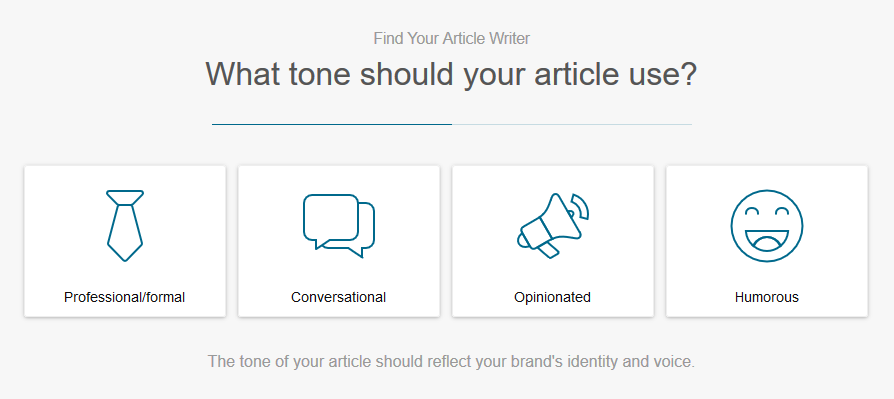
Then we made a mistake. Oops. No problem, we think. Oh, but it was. We had to go right back to the beginning and start again. How frustrating.
Finally, having got it all right, we got some results. Now here is where Fiverr really is quite different. Freelancers don’t bid on your project. You discover that all the data you just entered, was simply refining a search. You’re presented with the raw results.
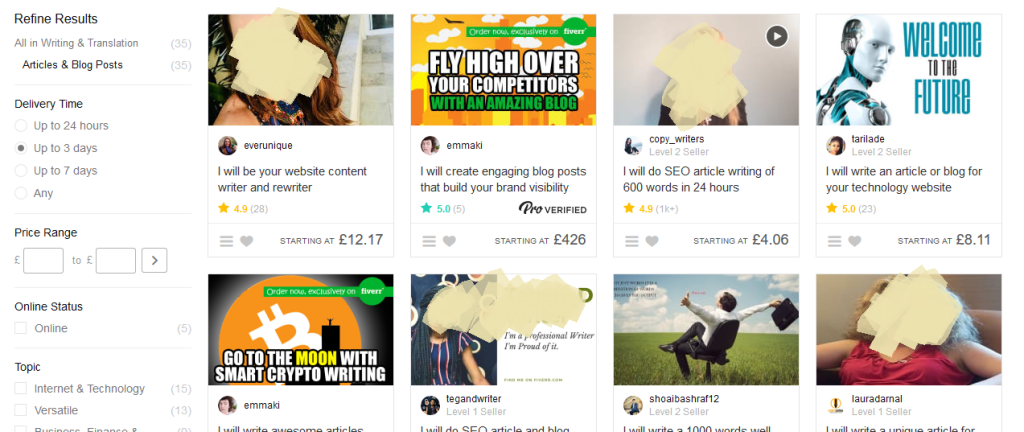
So, using the refining parameters to the left of the listings, we narrowed things down. We’re doing a lot of work here, and we’re all too aware that the listing isn’t saved anywhere. If the God of the Internet crashes the web, or the fire alarm goes off, we’re back at square 1.
Listing our job on Fiverr – The Results:
Having refined the search parameters a bit, we’re left with only 9 freelancers. However, now it’s even more complicated. Remember, these aren’t freelancers who have submitted a proposal based on our unique project specification.
What we are presented with, is a bunch of freelancer gigs which they have defined the parameters of. We’re going to have to shoe-horn our project in to what they offer. Hmm, not sure about that.
Let’s take a look at what that might look like. Here’s one of the gigs listed as fitting our search parameters:
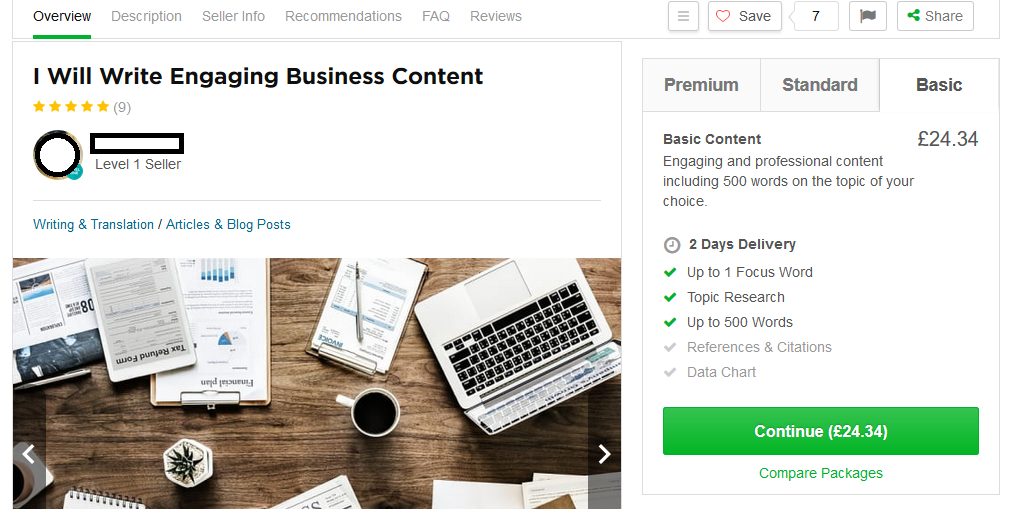
Yes, definitely hmm. We wanted 1000 words, not 500. Realistically, we were hoping to target three keywords too. Not quite what I was after. No problem, we can add some extras:
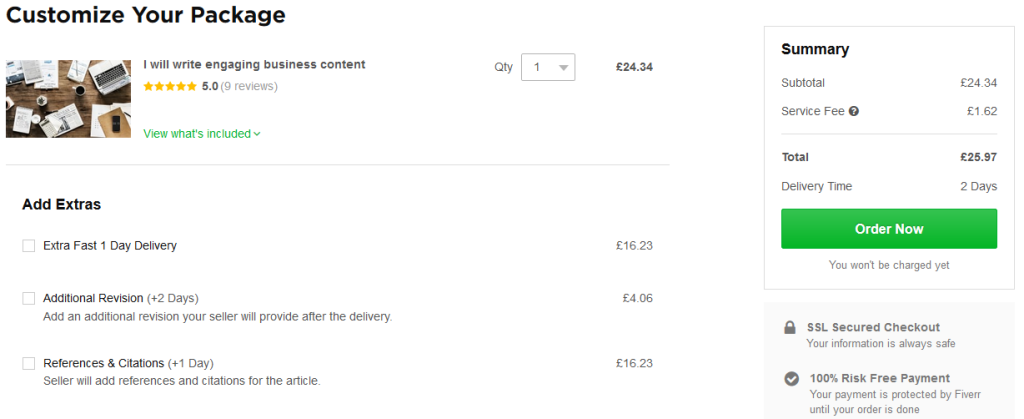
Right, not too happy about paying extra for revisions. High-quality writing is what we expect first time round. If revisions are needed, they should happen within the original fee. Furthermore, we’re not too enamoured with paying an additional £12.17 per 500 words to use a second keyword.
Now, let’s assume we found a potential ‘gig’ we liked (we didn’t), what would it cost?
What about Fiverr Fees?
A freelancer on Fiverr can list their jobs for free. The number of jobs or gigs they can list depends on how long they’ve been on Fiverr and things like feedback and billing amounts. However, just like People Per Hour and Upwork, 20% of the amount charged is lost to the platform in fees. It should also be noted that there are withdrawal fees associated with how you then access your money.
Sellers pay 5% of the gig total amount as a client fee. For orders less than $40 you pay a flat fee of $2, so more than 5% of smaller orders.
Fiverr– the good, the bad, the ugly
The Good: You can access ‘gigs’ instantly. If you’re prepared to compromise on what you want, you can get a job started very quickly.
The Bad: It’s basically a glorified search platform and you don’t get to list a bespoke project easily.
The Ugly: Given it is really just a search portal, why are they taking such high fees from freelancers?
Our Project on Freelancer
Freelancer is the original. It’s who we often think of in terms of freelancing platforms, so we had high hopes. All starts very promising. You can list a project brief with a reasonable amount of detail. You then get to choose whether you want to ‘post a project’ or ‘start a contest’.
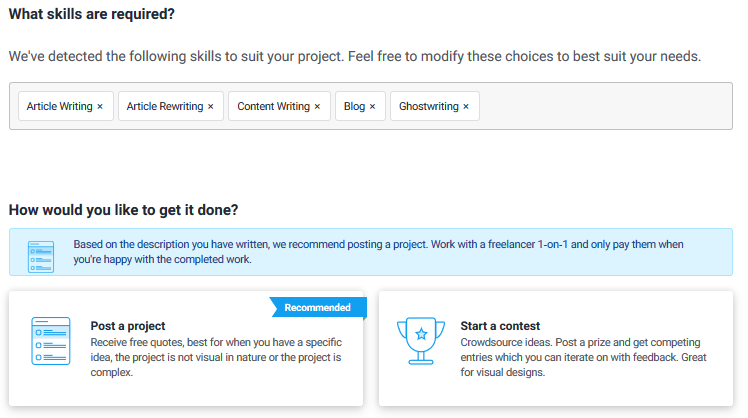
I‘Post a project’ is best suited to our dummy task. You then choose whether to pay a fixed price or by the hour. Fixed price works best here, so we went for that, choosing a range of £20 – £250. There are the parameters of a Freelancer ‘simple project’.
Then we listed our project.
Listing our job on Freelancer – The Results:
Frankly, there should have been a ‘brace yourself’ warning. Having been pretty disappointed with the number of freelancers we accessed on People Per Hour, Upwork and Fiverr, we were not prepared for the avalanche about to happen.
Within 90 seconds (yes, you read that correctly), we had 21 expressions of interest. Many of these said they had “read the brief in detail”… erm, no, we don’t think so.
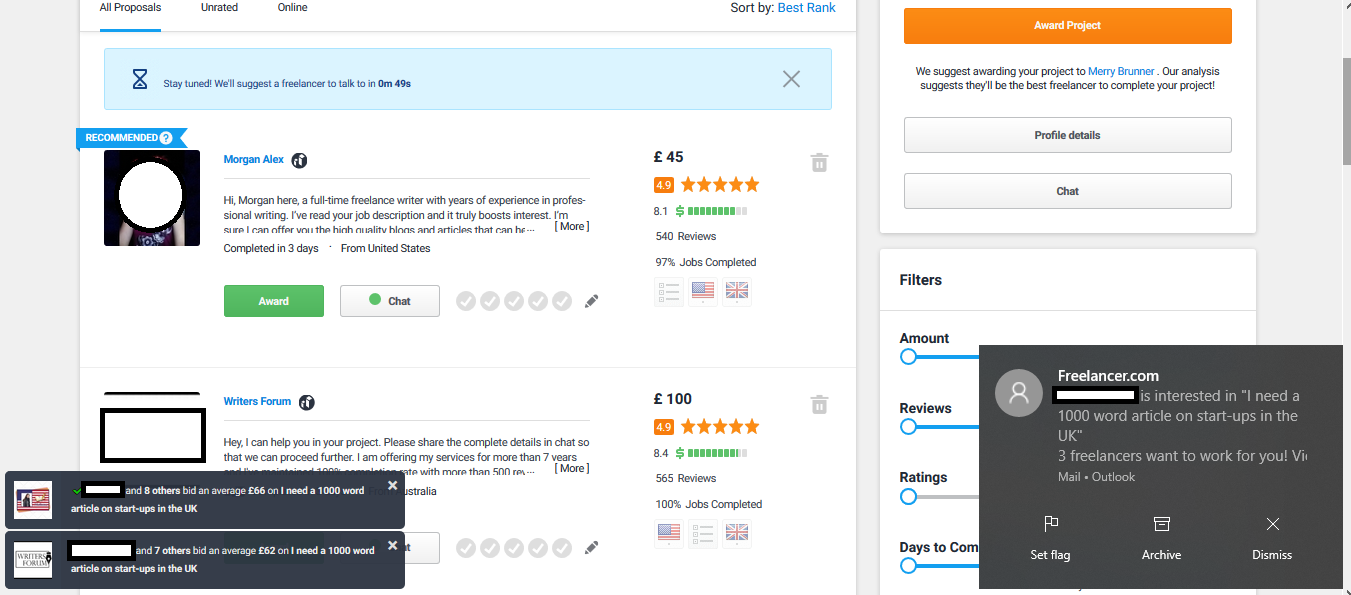
Within 3 minutes we had a live chat invitation pop up with Freelancer’s own chosen favourite candidate. By this stage, we had 30 expressions of interest. Prices seemed to be fair-ish. The lowest was £25 which realistically isn’t going to buy you quality, once fees are taken in to account. The highest was £90 which is at the high end of acceptable for a skilled writer.
By the time we cancelled the listing four hours later, we had a total of 61 bids, with an average price of £58. So we were grateful for the refinement sliders on offer:
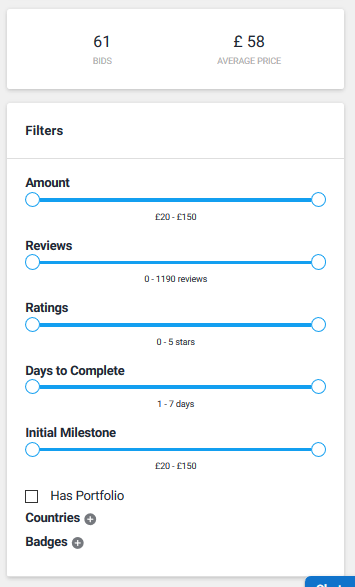
Out of the crazy torrent of proposals, Freelancer recommends just one. We can’t quite figure out the parameters of how they came up with selecting this particular freelancer. That said, even when we discounted the non-native English speakers, and used the sliders to refine our selection, we had a pretty decent pool of talent.
We had a good handful of freelancers who we would be happy to have working on our project. Thumbs up to Freelancer in terms of quality available with some excellent UK copywriters!
What about Freelancer Fees?
Much like the other platforms, buyers can post a job and review the applicants for free. They are then charged 3% or $3 (whichever is greater) of the project amount.
Freelancers too, can set up a profile for free. They get 8 free bidding credits per month and then will need to buy more. Upgrades to the bids can be bought which will promote your bid (we’re guessing this is where the recommended freelancer came in).
Freelancer fees for the freelancer are in line with all the other platforms at 20%.
Freelancer– the good, the bad, the ugly
The Good: We were pretty impressed with the quality of the freelancers that we got.
The Bad: It’s absolutely overwhelming to receive that many proposals in just a few minutes. There’s no way they were tailored. That said, we could use the sliders to refine our parameters. After the initial panic of how we would filter that number of proposals, we were pleased.
The Ugly: We don’t like a freelancer being able to pay to boost their proposal. As a buyer you should be selecting on talent, feedback and price alone.
Our overall verdict on freelancer platform comparisons
Our overall verdicts on the main different freelance websites can be seen here:

All in all, we’re not overly impressed. This is a real shame. Freelance platforms could be (and indeed were) ideal ways of sourcing the talent you need on an ‘as needed’ basis. There are some common problems:
· Seller fees: No matter how you look at it, 20% seller fees is astronomical and unfair. For all freelancing platforms, these have spiked in recent years, jeopardising individual freelancer’s livelihoods. However, this isn’t ‘just’ a seller’s problem. It is also a problem for the buyers. Quality freelancers have to factor these seller fees in to their proposal amounts. In essence, they have no choice but to pass the fees on. Find these freelancers directly, and you’ll likely pay 20% less for the exact same service. This sets freelancers and buyers off to a poor start. Both is at risk of feeling taken advantage of.
· Curation of talent: Freelance platforms don’t properly curate talent. Some do so more than others. However, you cannot guarantee that you are getting a high-quality freelancer suited to your project. On one hand this is great as you can get access to talent around the world. For some projects, such as logo design, this means that you get expertise at a fraction of the cost of the same skills within the UK. For other projects, such as writing tasks, you cannot be sure that all available talent meets your absolute minimum requirements.
· Communication: The success of collaboration on freelance projects is entirely dependent on exceptional communication between buyer and seller. Different platforms try to address this in different ways. However, they are all hoisted by their own fear of having the project taken ‘off platform’. The result is phone chats, email communication, instant messaging and other forms of communication are usually strongly discouraged.
· Pricing: Buyers have a real problem knowing they are paying a fair price for the job. You could be paying too much and being taken for a mug. Alternatively, you could be expecting to pay too little and therefore failing to achieve the quality you need, or indeed expect.
· It’s time consuming: No matter which platform you choose, you’re required to do a vast amount of the legwork. This may be hunting down the freelancers and trawling profiles. It may be clearing out your inbox of the multiple proposals that simply don’t cut the mustard.
· You’re unlikely to find the best: The most popular (and therefore busy) freelancers aren’t hugely active on freelancer platforms. They likely have a profile or two from their early days, but now they are so busy working directly for clients, platforms aren’t usually the place to find them. They are fed up of wasted time bidding against freelancers from overseas who, on first glance, can undercut on price. Furthermore, the clients who have these freelancers in their clutches really don’t want to let go. They are worth their weight in gold. To get any chance of accessing these ‘cream of the crop’ freelancers, you need to go direct.
So, those needing projects done and freelancers alike are left with a tricky problem: how to find each other. The benefits of freelancing for both parties are hugely valuable, so it’s still worth pursuing as an option for both sides.
The solution to freelancer platforms
The solution is to use businesses, who are specialist in their niche, who can access the best freelancers all the time. By using a ‘shop’ based approach, buyers can choose the service they need at a fair rate for high-quality. The freelancer receives fair pay for the work they do, ensuring a consistently high standard. It gets us back to the win-win nature of freelancing.
The Content Ninja is a specialist one-stop shop when it comes to content writing. You pay a fixed and fair price for your work, based on only ever being matched with an exceptional UK copywriter. Order here.
Chris Brown is owner of The Content Ninja. With many years’ experience in freelancing, Chris has direct experience with freelance platforms. Chris is passionate about freelancers and businesses finding each other to create a win-win for both parties. It’s the way of doing business in the digital age

